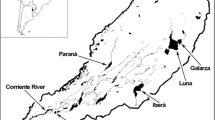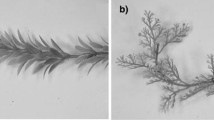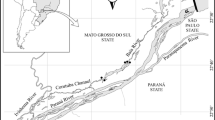Abstract
Habitat structural complexity provided by aquatic macrophytes in lowland streams affects the associated epiphytic macroinvertebrate assemblages in both direct (increased microhabitat diversity, refuge against predation) and indirect ways (e.g. current attenuation by physical structures). In a correlative field study carried out in two different years in a Belgian stream, we investigated the effects of the factors macrophyte identity, macrophyte complexity (represented as fractal complexity) and current velocity on the composition of the macroinvertebrate community associated with monospecific macrophyte patches, consisting of plants with differing structural complexity; Sparganium emersum Rehmann (least complex), Potamogeton natans L. (intermediate) and Callitriche obtusangula Le Gall (most complex). In addition to significantly lower within-patch current velocity being observed, vegetation stands consisting of complex macrophytes also harboured significantly richer macroinvertebrate communities than stands of simpler macrophytes. A significant part of the variation in the macroinvertebrate community composition could be explained by plant identity, macrophyte complexity and current velocity. However, it was not possible to determine the relative importance of these three factors, because of their high degree of intercorrelation. Additionally, the explanatory power of these factors was higher under conditions of high current velocity, suggesting a role of macrophyte patches as instream flow refugia for macroinvertebrates.





Similar content being viewed by others
References
Armitage, P. D., I. Pardo & A. Brown, 1995. Temporal constancy of faunal assemblages in mesohabitats – application to management. Archiv Fur Hydrobiologie 133: 367–387.
Bartholomew, A. & R. L. Shine, 2008. Space size relative to prey width (Sp/Py) influences macrofaunal colonization of artificial structures. Marine Ecology Progress Series 358: 95–102.
Bartholomew, A., R. J. Diaz & G. Cicchetti, 2000. New dimensionless indices of structural habitat complexity: predicted and actual effects on a predator’s foraging success. Marine Ecology Progress Series 206: 45–58.
Bell, N., T. Riis, A. M. Suren & A. Baattrup-Pedersen, 2013. Distribution of invertebrates within beds of two morphologically contrasting stream macrophyte species. Fundamental and Applied Limnology 183: 309–321.
Connor, E. F. & E. D. McCoy, 1979. Statistics and biology of the species-area relationship. American Naturalist 113: 791–833.
Crowder, L. B. & W. E. Cooper, 1982. Habitat structural complexity and the interaction between bluegills and their prey. Ecology 63: 1802–1813.
Den Hartog, C. & G. Van der Velde, 1988. Structural aspects of aquatic plant communities. In Symoens, J. J. (ed.), Vegetation of inland waters Handbook of vegetation science. Springer, Dordrecht: 113–153.
Elliott, J. M., 2003. A comparative study of the dispersal of 10 species of stream invertebrates. Freshwater Biology 48: 1652–1668.
Ferreiro, N., C. Feijoo, A. Giorgi & L. Leggieri, 2011. Effects of macrophyte heterogeneity and food availability on structural parameters of the macroinvertebrate community in a Pampean stream. Hydrobiologia 664: 199–211.
Finelli, C. M., D. D. Hart & R. A. Merz, 2002. Stream insects as passive suspension feeders: effects of velocity and food concentration on feeding performance. Oecologia 131: 145–153.
Gaevskaya, N. S., 1969. The role of higher aquatic plants in the nutrition of the animals of freshwater basins (trans: Mann KH), vol 1–3. National Lending Library of Science and Technology, Boston Spa.
Heck Jr., K. L. & L. B. Crowder, 1991. Habitat structure and predator—prey interactions in vegetated aquatic systems. In Bell, S., E. McCoy & H. Mushinsky (eds), Habitat Structure, Vol. 8., Population and Community Biology Series Springer, Dordrecht: 281–299.
Heino, J., 2005. Functional biodiversity of macroinvertebrate assemblages along major ecological gradients of boreal headwater streams. Freshwater Biology 50: 1578–1587.
Hill, M. O., 1973. Diversity and evenness: a unifying notation and its consequences. Ecology 54: 427–432.
Hill, M. O. & P. Smilauer, 2005. TWINSPAN for Windows version 2.3. Centre for Ecology and Hydrology & University of South Bohemia, Huntingdon & Ceske Budejovice.
Kovalenko, K., E. D. Dibble & R. Fugi, 2009. Fish feeding in changing habitats: effects of invasive macrophyte control and habitat complexity. Ecology of Freshwater Fish 18: 305–313.
Lancaster, J. & A. G. Hildrew, 1993. Flow refugia and the microdistribution of lotic macroinvertebrates. Journal of the North American Benthological Society 12: 385–393.
MacArthur, R. & E. O. Wilson, 1967. The Theory of Island Biogeography. Princeton University Press, Princeton.
Madsen, J. D., P. A. Chambers, W. F. James, E. W. Koch & D. F. Westlake, 2001. The interaction between water movement, sediment dynamics and submersed macrophytes. Hydrobiologia 444: 71–84.
Matias, M. G., A. J. Underwood, D. F. Hochuli & R. A. Coleman, 2010. Independent effects of patch size and structural complexity on diversity of benthic macroinvertebrates. Ecology 91: 1908–1915.
McAbendroth, L., P. M. Ramsay, A. Foggo, S. D. Rundle & D. T. Bilton, 2005. Does macrophyte fractal complexity drive invertebrate diversity, biomass and body size distributions? Oikos 111: 279–290.
McNett, B. J. & A. L. Rypstra, 2000. Habitat selection in a large orb-weaving spider: vegetational complexity determines site selection and distribution. Ecological Entomology 25: 423–432.
Moller Pillot, H. K. M., 2009. Chironomidae Larvae. Biology and Ecology of the Chironomini. KNNV Publishing, Zeist.
Moog, O., 1995. Fauna Aquatica Austriaca. Katalog zur autökologischen Einstufung aquatischer Organismen Österreichs. Bundesministerium für Land und Forstwirtschaft, Umwelt und Wasserwirtschaft, Wasserwirtschaftskataster, Wien.
O Hare, M. T. & K. J. Murphy, 1999. Invertebrate hydraulic microhabitat and community structure in Callitriche stagnalis Scop. patches. Hydrobiologia 415: 169–176.
Palm, E., 1986. Unterfamilie Nymphulinae Nordeuropas Pyralider, med saerligt henblik pa den danske fauna (Lepidoptera: Pyralidae). Danmarks Dyreliv Bind 3, Stenstrup: 114–123.
Pardo, I. & P. D. Armitage, 1997. Species assemblages as descriptors of mesohabitats. Hydrobiologia 344: 111–128.
Peralta, G., L. A. van Duren, E. P. Morris & T. J. Bouma, 2008. Consequences of shoot density and stiffness for ecosystem engineering by benthic macrophytes in flow dominated areas: a hydrodynamic flume study. Marine Ecology Progress Series 368: 103–115.
Sand-Jensen, K. & J. R. Mebus, 1996. Fine-scale patterns of water velocity within macrophyte patches in streams. Oikos 76: 169–180.
Schmid, P. E., M. Tokeshi & J. M. Schmid-Araya, 2002. Scaling in stream communities. Proceedings of the Royal Society B: Biological Sciences 269: 2587–2594.
Schoelynck, J., D. Meire, K. Bal, K. Buis, P. Troch, T. Bouma, P. Meire & S. Temmerman, 2013. Submerged macrophytes avoiding a negative feedback in reaction to hydrodynamic stress. Limnologica 43: 371–380.
St Pierre, J. I. & K. E. Kovalenko, 2014. Effect of habitat complexity attributes on species richness. Ecosphere 5: 1–10.
Stevens, R. D., S. B. Cox, R. E. Strauss & M. R. Willig, 2003. Patterns of functional diversity across an extensive environmental gradient: vertebrate consumers, hidden treatments and latitudinal trends. Ecology Letters 6: 1099–1108.
Tachet, H., J. P. Pierrot, C. Roux & M. Bournaud, 1992. Net-building behaviour of six Hydropsyche species (Trichoptera) in relation to current velocity and distribution along the Rhône river. Journal of the North American Benthological Society 11: 350–365.
Taniguchi, H., S. Nakano & M. Tokeshi, 2003. Influences of habitat complexity on the diversity and abundance of epiphytic invertebrates on plants. Freshwater Biology 48: 718–728.
Ter Braak, C. J. & P. Smilauer, 2012. Canoco Reference Manual and User’s Guide: Software for Ordination, Version 5.0. Microcomputer Power, Ithaca.
Thomaz, S. M. & E. R. da Cunha, 2010. The role of macrophytes in habitat structuring in aquatic ecosystems: methods of measurement, causes and consequences on animal assemblages’ composition and biodiversity. Acta Limnologica Brasiliensia 22: 218–236.
Townsend, C. R., R. M. Thompson, R. R. McIntosh, C. Kilroy, E. Edwards & M. R. Scarsbrook, 1998. Disturbance, resource supply, and food-web architecture in streams. Ecology Letters 1: 200–209.
Verdonschot, R. C. M. & E. Peeters, 2012. Preference of larvae of Enallagma cyathigerum (Odonata: Coenagrionidae) for habitats of varying structural complexity. European Journal of Entomology 109: 229–234.
Verdonschot, R. C. M., K. Didderen & P. F. M. Verdonschot, 2012. Importance of habitat structure as a determinant of the taxonomic and functional composition of lentic macroinvertebrate assemblages. Limnologica 42: 31–42.
Verschoren, V., J. Schoelynck, K. Buis, F. Visser, P. Meire & S. Temmerman, 2017. Mapping the spatio-temporal distribution of key vegetation cover properties in lowland river reaches, using digital photography. Environmental Monitoring and Assessment 189: 294.
VMM - Flemish Environment Agency, 2016. Geoloket waterkwaliteit. http://geoloket.vmm.be/Geoviews/.
Warfe, D. M. & L. A. Barmuta, 2004. Habitat structural complexity mediates the foraging success of multiple predator species. Oecologia 141: 171–178.
Warfe, D. M. & L. A. Barmuta, 2006. Habitat structural complexity mediates food web dynamics in a freshwater macrophyte community. Oecologia 150: 141–154.
Warfe, D. M., L. A. Barmuta & S. Wotherspoon, 2008. Quantifying habitat structure: surface convolution and living space for species in complex environments. Oikos 117: 1764–1773.
Winterbottom, J. H., S. E. Orton, A. G. Hildrew & J. Lancaster, 1997. Field experiments on flow refugia in streams. Freshwater Biology 37: 569–580.
Acknowledgements
Our thanks go to Susana Romero Chavez and Dorine Dekkers for their respective help with sorting and identifying the macroinvertebrates. The first author would like to thank the Biology Department of the University of Antwerp for providing a doctoral grant. Jonas Schoelynck is a postdoctoral fellow of FWO (Project No. 12H8616 N). Furthermore, we would like to thank the two anonymous reviewers, whose comments have significantly improved the manuscript.
Author information
Authors and Affiliations
Corresponding author
Additional information
Handling editor: Katya E. Kovalenko
Electronic supplementary material
Below is the link to the electronic supplementary material.
Rights and permissions
About this article
Cite this article
Wolters, JW., Verdonschot, R.C.M., Schoelynck, J. et al. The role of macrophyte structural complexity and water flow velocity in determining the epiphytic macroinvertebrate community composition in a lowland stream. Hydrobiologia 806, 157–173 (2018). https://doi.org/10.1007/s10750-017-3353-6
Received:
Revised:
Accepted:
Published:
Issue Date:
DOI: https://doi.org/10.1007/s10750-017-3353-6




